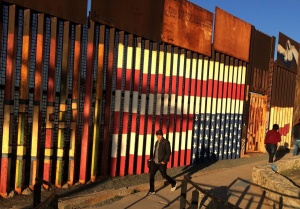Distress Flag Mural (public art)
Artist: Amos Gregory and deported veterans
Year: 2018
Date of Action: April-June 2018
Region: North America
Location: San Diego-Tijuana border
Subject: Political/Economic/Social Opinion
Medium: Public Art
Confronting Bodies: United States Customs and Border Protection (USCBP) and Daniel Kitzman, a supervisory border agent for the San Diego Sector of the US Border Patrol
Description of Artwork: 'The Distress Flag Mural' was created by Amos Gregory, a San Francisco-based muralist, community activist and disabled Navy veteran. This was part of the Veterans Mural Project, or Veterans Alley, in attempts to highlight the adversities of US veterans.
In 2013, the artist collaborated with a group of 20 deported veterans to design a mural on the south side of the San Diego-Tijuana border wall, referred to as the 'Friendship Circle'. Occasionally opened by the US Border, this area has become a meeting point for seperated families.
The painting depicts a distressed (inverted) US flag with crosses, representing the upsetting reality of nearly 70 veterans in Tijuana, Mexico. Following their discharge from the military, several veterans were convicted of crimes and subsequently deported. With this artwork, Gregory aimed to encapsulate the emotional, psychological and medical damages of these deported veterans, which cannot be treated adequately in Mexico.
The Incident: In April of 2018, following the President's visit near the California-Mexico border, the USCBP received complaints that the mural is a violating form of "graffiti".
Thereafter, Daniel Kitzman, a supervisory border agent for the San Diego Sector of the US Border Patrol, contacted Hector Lopez, co-founder of the US Deported Veterans support house, obliging Gregory to remove or alter the painted flag. This was the first objection made since the creation of the mural five years ago, insinuating political disagreements and an attempt by the federal government to squelch free speech. Subsequently, Gregory refused to change the painting, asserting that his aim was to "raise awareness around the issue of deported veterans. It's not about us trying to take on our own government or us trying to create imagery that's hostile toward the United States of America" (Gregory, April 2018).
The National Coalition Against Censorship (NCAC) advised USCBP, to respect the artistic expression of deported US military veterans and artists, who are protected by federal acts and the First Amendment. NCAC wrote a letter to the San Diego Sector of USCBP on this basis.
Results of Incident: The decision of the USCBP regarding the removal of the mural is still pending.
Source:
US Customs and Border Control Urged Not to Destroy Art by Deported Veterans, NCAC, June 25, 2018.
Deported vets helped paint this upside-down US flag on the border. Will they have to remove it?, CNN, April 20, 2018.
For years a flag mural at the border has honored deported U.S. military veterans. After Trump visit, agents are looking into taking it down., The Washington Post, May 16, 2018.
